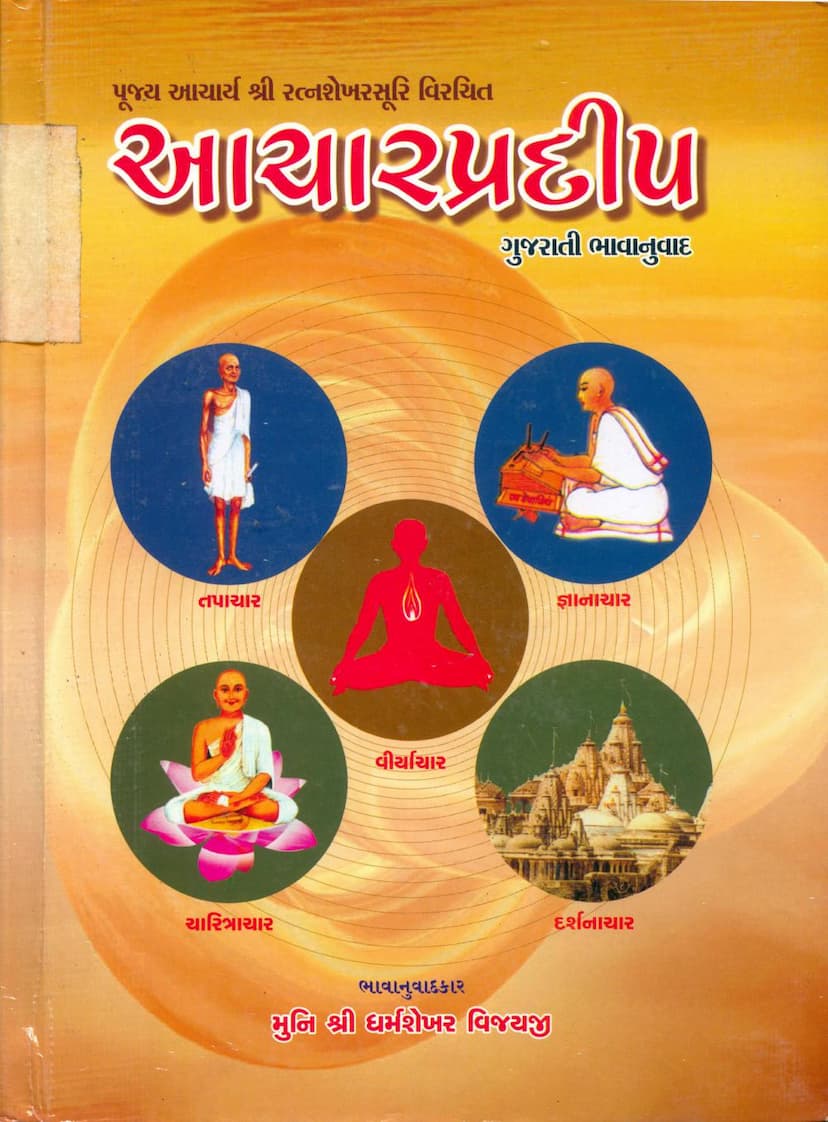Acharpradip
Added to library: September 1, 2025

Summary
Here's a comprehensive summary of the Jain text "Acharpradip" by Dharmshekharvijay, based on the provided pages and catalog link.
Acharpradip: A Comprehensive Summary
"Acharpradip" (The Lamp of Conduct) is a significant Jain text authored by Acharya Shri Ratneshekhar Suri and translated into Gujarati by Muni Shri Shikhar Vijayji. Published by Shri Arihant Aradhak Trust, this work is dedicated to elucidating the foundational principles of Jain conduct, known as the "Panchachar" (Five Conducts).
Core Subject Matter: The Five Pillars of Conduct (Panchachar)
The primary focus of "Acharpradip" is a detailed exploration of the five essential pillars of Jain practice:
-
Gyanachar (Conduct of Knowledge): This section emphasizes the importance and intricacies of right knowledge. It outlines eight types of Gyanachar, detailing how knowledge should be pursued, understood, and applied. The text highlights the supremacy of Shruta Gyan (scriptural knowledge) and its role in illuminating other forms of knowledge. It expounds upon various aspects of knowledge acquisition, such as understanding time-related knowledge, cultivating respect for knowledge and its sources, the practice of Upadhan (austerities undertaken during study), avoiding errors in pronunciation and meaning, and the proper approach to various subjects. The detailed narrative of King Prithipal illustrates the profound impact of devoted adherence to scriptural knowledge.
-
Darshanachar (Conduct of Faith/Vision): This part delves into the eight aspects of correct faith or vision (Darshan). It underscores the significance of unwavering faith in the Tattvas (realities) and the Jina-mata (teachings of the Jinas). The text emphasizes practices like venerating Jain idols and temples, serving the monks and nuns, and cultivating steadfastness in one's chosen religious path, even in the face of adversity. The stories of Kokash and Kakjhangha kings serve as powerful examples of how righteous conduct and unwavering faith lead to auspicious outcomes.
-
Charitraachar (Conduct of Behavior/Asceticism): This extensive section details the eight types of righteous behavior and conduct essential for both ascetics (monks and nuns) and lay followers (shravaks). It covers principles such as Irviasamiti (careful movement), Bhashasamiti (careful speech), Eshanasamiti (careful alms-seeking), Adan-nikshepanasamiti (careful handling of objects), Pariṣṭhāpanikāsamiti (careful disposal of waste), Manogupti (control of mind), Vachanagupti (control of speech), and Kayagupti (control of body). The text elaborates on the practices and disciplines required to maintain purity in these aspects of conduct, emphasizing the importance of mindful actions and the avoidance of even subtle transgressions.
-
Tapachar (Conduct of Austerities): "Acharpradip" outlines twelve types of austerities (Tapas) that are crucial for spiritual purification and the shedding of karmas. These are categorized into two main types: external austerities (Bahya Tapas) and internal austerities (Abhyantar Tapas). External austerities include practices like fasting (Anashan), reducing intake (Unodari), restricting activities (Vrutti Samkshep), renouncing specific tastes (Rasatyag), enduring hardship (Kayaklesh), and practicing solitude (Sanlinata). Internal austerities encompass atonement (Prayashchitta), humility (Vinay), service (Veyavachcha), study (Swadhyay), meditation (Dhyan), and renunciation of the body (Kayotsarg). The text stresses that austerities should be undertaken with the sole aim of purifying the soul and shedding karmas, not for worldly gain or recognition.
-
Viryachar (Conduct of Valor/Effort): This final pillar emphasizes the crucial role of sustained effort and strength (Virya) in spiritual progress. It details thirty-six aspects of Viryachar, highlighting the need for consistent and energetic practice of the other four conduct pillars. The text stresses that spiritual endeavors require unwavering effort and diligence, and that even small efforts, when performed with sincerity and perseverance, can lead to significant spiritual advancement. The stories within this section often illustrate the power of consistent effort and the consequences of its absence.
Key Features of "Acharpradip":
- Explanatory Style: The author, Acharya Ratneshekhar Suri, employs a clear and engaging style, often using illustrative stories and examples (drishtanta) to explain complex concepts. These narratives are designed to maintain the reader's interest and deepen their understanding of the principles.
- Emphasis on Purity: A recurring theme is the necessity of pure adherence to these conduct principles. The text highlights the potential pitfalls and "Aticharas" (transgressions) associated with each conduct, urging readers to avoid them and focus on the correct practice.
- Guidance for Both Ascetics and Laypersons: While detailing the conduct for ascetics, the text also provides guidance relevant to lay followers, emphasizing the practical application of these principles in daily life.
- Comprehensive Scope: The book meticulously details the various sub-categories within each of the five pillars, presenting a holistic view of Jain ethical and spiritual practice.
- Merit of Knowledge and Effort: The text consistently reinforces the idea that knowledge is the foundation for right action and that diligent effort (Virya) is essential for spiritual realization.
Translation and Publication:
The Gujarati translation by Muni Shri Shikhar Vijayji makes this profound Sanskrit-Prakrit text accessible to a wider audience. The publication by Shri Arihant Aradhak Trust, with the support of various patrons, signifies its importance in disseminating Jain teachings. The initial printing runs and pricing suggest it was intended for broad distribution within the Jain community.
Overall Significance:
"Acharpradip" serves as a vital guide for understanding and implementing the core ethical and spiritual disciplines within Jainism. It emphasizes that the consistent and pure practice of these five conducts is the path to self-welfare and ultimately, liberation (Moksha). The inclusion of illustrative stories makes the abstract principles relatable and the text a valuable resource for spiritual learning and practice.